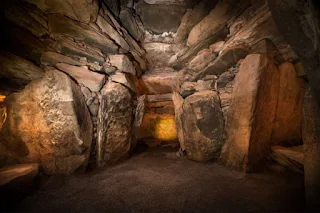 |
| Newgrange burial mound, County Meath, Ireland Photo credit: Ken Williams" |
It makes a pleasant change to be able to write about something that isn't related to covidiot religious fundamentalists doing their bit to spread the Covid-19 virus, debunking creationist frauds with facts as revealed by science or to Catholic priests abusing children for recreation.
This is about Ireland and Irish history, something in which I have long taken an interest and written about in my popular book, A History of Ireland: How Religion Poisoned Everything".
Religion seems to have played as big a part then as it did until recently in the island of Ireland.
 |
| Interior of the Newgrange chambered tomb. Photo credit: Ken Williams |
Normally, incest is highly taboo in most human societies and tends to be restricted to elite rulers endowed with divine, god-like qualities, as a way of preserving these qualities and so their entitlement to rule. Tutankhamun might have been the child of Akhenaten and his sister, for example and incest was practiced by the ruling elite in South America's Inca society.
 |
| Inside the burial chamber at Newgrange. The rising sun at the mid-winter solstice illuminates the inner chamber for a few minutes. |
By analysing the DNA of 2 Mesolithic and 42 Neolithic individuals and combining this with DNA analyses previously carried out on 16 Neolithic (approximately 4000–2500 BC) and Early Bronze Age (2200–1500 BC) individuals from Ireland, the team were able to shed more light on the origins of the hunter-fisher-forager and late farmer inhabitants of Ireland. It showed a web of familial connections between the man buried in Newgrange and those buried in other prestigious burial sites throughout Ireland such as Carrowmore and Carrowkeel in County Sligo, suggesting a powerful kin-group of local chiefs and petty kings, lasting for about 500 years.
 |
| Poulnabrone portal tomb, where the earliest diagnosed Down's Syndrome child was buried. Photo credit: Getty Images |
Ireland's Neolithic inhabitants trace back to an expansion into Europe of people out of Anatolia (modern Turkey) about 6-7,000 years ago. These people brought agriculture to a people for whom hunting and foraging had been the normal way of life. Genetically, these first farmers to settle in Ireland were closest to people living at that time in Iberia (modern Spain and Portugal). There people probably spread round the Mediterranean coast to Iberia and then round the coast into western France and across to the British Isles.
In the rest of Europe and Great Britain, these new arrivals quickly replaced the local hunter-gatherer people who were genetically similar but distinct from the hunter-gatherer people of Ireland, where genetic isolation had led to a distinctive genome. These Irish hunter-gatherers were probably dark-skinned with blue eyes, whereas the Anatolian farmers were pale-skinned with brown eyes. Evidently, the Irish Sea had been a major barrier to intermixing to these Mesolithic hunter-gatherers, but not to these later immigrants.
It's not clear whether the new-comers exterminated the hunter-gatherers or simply overwhelmed and displaced them with sheer numbers, however, the DNA of two individuals from a wedge tomb at Parknabinnia, County Clare showed a high level of Mesolithic DNA, suggesting intermixing between the two populations.
What we see in these burials is the link between religion and rule and the beginnings of the hold religion had on the people of Ireland until the very recent rejection of the moral authority of the Catholic Church. It was the same connection we see between religion and the ruling elite we still see in the remaining European and Middle Eastern monarchies, where the monarch claims a divine right to govern and their position is sanctified and legitimised by religious ceremonies conducted by the chief priest. It can even include anointing the new monarch's head with magical oils supposedly containing some divine magical substance conveying that divine authority, permission and blessing.
The elements of this superstitious basis for the divine right of kings were clearly present in Europe 5,000 years ago, and may have been brought in by migrant farmers from ancient Anatolia.


No comments :
Post a Comment
Obscene, threatening or obnoxious messages, preaching, abuse and spam will be removed, as will anything by known Internet trolls and stalkers, by known sock-puppet accounts and anything not connected with the post,
A claim made without evidence can be dismissed without evidence. Remember: your opinion is not an established fact unless corroborated.